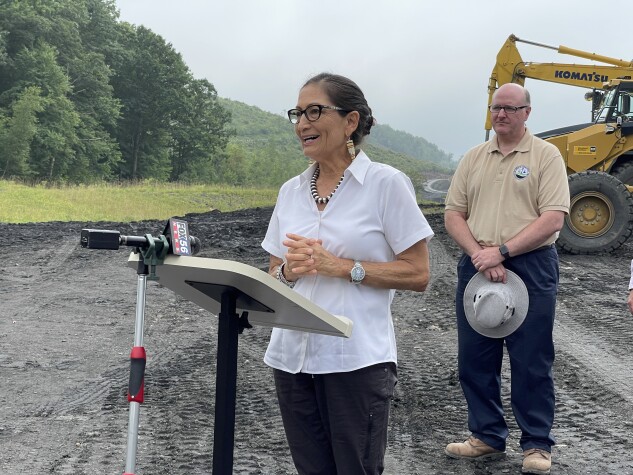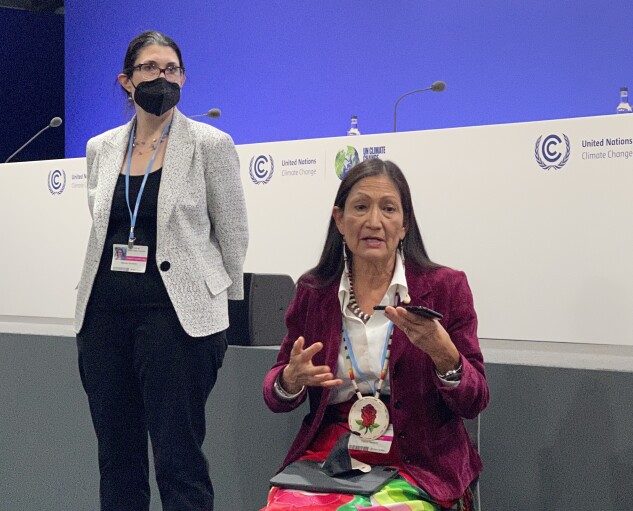- Haaland’s term as Interior secretary elevated tribal voices
- Secretary’s other key achievements unclear, legal experts say
Interior Secretary Deb Haaland will be remembered for being the first Native American to serve in that role, but her legacy is mixed because she either did too much to vanquish fossil fuels on federal land, or too little, advocates and environmental attorneys say.
Martha Williams, US Fish and Wildlife Service director, summed up Haaland’s legacy during the dedication of a new national wildlife refuge in southern Maryland on Dec. 13, which featured members of the Piscataway tribal community.
Haaland’s sense of fairness, care for imperiled species, and “impeccable moral compass” have permeated all of the Interior Department’s decisions during the Biden administration, Williams said.
The Interior Department during Haaland’s tenure expanded safeguards for endangered species, took steps to gird federal lands for climate change, slowed oil and gas leasing, worked with the White House to expand or create vast national monuments, and blocked some oil drilling and mining in Alaska’s Arctic while also approving
Those efforts have angered many Republicans in Western states, who have accused Haaland of chronic lawbreaking in service of the White House’s climate change agenda.
Haaland is likely to be succeeded by former North Dakota Gov. Doug Burgum (R), whom President-elect Donald Trump nominated to promote widespread fossil fuels development. The second Trump administration is expected to try to erase or reverse many of Interior’s actions taken under Haaland’s leadership.
Haaland, a Democrat who is expected to consider a run for New Mexico governor, declined multiple requests for an interview.
Giving Hope to Tribes
Regardless which party controls Congress and the White House, the federal government is legally obligated to engage tribes, so Haaland’s efforts to do so are likely to remain in place, said Heather Tanana, a water law professor at the University of California-Irvine School of Law and member of the Navajo Nation.
Under Haaland’s leadership, the Interior Department launched the Federal Indian Boarding School Initiative. The effort reports on atrocities associated with Interior’s historical role in removing Native American children from their families and sending them to hundreds of boarding schools, where they were stripped of their tribal identities and subject to manual labor and abuse, according to a 2022 department report.
“Her work to confront the harms caused by Indian Boarding Schools shed a light on a tragic era in the country’s history, helping to educate folks who may not have known about the damage the schools caused, and start a path toward healing,” said Sarah Matsumoto, director of the environmental law clinic at the University of Colorado Law School.
Haaland, a member of the Pueblo of Laguna, was the first Interior secretary who understood tribes’ need for healing and consultation after generations of mistreatment, said Davina Smith, a member of Navajo Nation in Utah.
“She gave hope,” Smith said. “To work with her—with someone that gets where we are coming from in terms of tribes, that was something, it was a great honor.”
Some of the department’s most durable efforts under Haaland were its work on tribal water rights settlements in the West and support for water infrastructure on Indian reservations, Tanana said.
Interior received $2.5 billion from the bipartisan infrastructure law to settle tribes’ water rights claims that had been left unadjudicated, preventing them from accessing water they are entitled to.
“Insufficient funding of federal programs serving tribal communities has historically been viewed as a failure of the federal government to fulfill its treaty and trust responsibilities,” Tanana said. “The efforts to settle outstanding tribal water rights and to complete tribal water infrastructure projects will have long-lasting impact.”
A ‘Passive’ Secretary
As many tribes and environmental groups see her as a crucial ally who fervently defended public lands, members of the fossil fuels industry accuse Haaland of lawlessness.
Kathleen Sgamma, president of the Western Energy Alliance, which represents oil and gas companies operating on federal land in the West and has challenged Haaland’s efforts to halt drilling in court, called Haaland a “passive” Interior secretary who was unable to effectively answer questions in congressional hearings.
Sgamma accused Haaland of restricting leasing and other mineral access while approving the Bureau of Land Management’s Public Lands Rule, which requires that conservation efforts be considered a “use” of public lands under the agency’s multiple land-use mandate.
“The BLM conservation rule, which is so clearly outside the law,” is among Interior Department actions under Haaland’s leadership likely to be heavily scrutinized by courts and the incoming Trump administration, Sgamma said.
Haaland failed to recognize how Interior’s restrictions on oil and gas in Wyoming affected the state and its economy, Sen. John Barrasso (R-Wyo.) said during a Senate hearing in May.
“What’s even more disturbing is how many of Secretary Haaland’s decision are lawless,” including the Bureau of Land Management’s failure to hold quarterly lease sales, he said.
Beyond Haaland’s support for tribal sovereignty, “it’s hard to list or identify—even with the aid of DOI’s website!—key achievements or programs of her administration,” Murray Feldman, a partner at Holland & Hart LLP in Boise, Idaho, said in an email.
“Certain initiatives seemed to be more administration-wide or White House-led efforts that Interior played a role in implementing,” he added.
Haaland made some progress reducing damage from oil and gas production on federal lands and orphaned wells abandoned by oil companies, but much more needs to be done, said Erik Schlenker-Goodrich, executive director of the Western Environmental Law Center in New Mexico.
“It’s a false narrative that the administration turned its back on the oil and gas industry,” he said.
Haaland promoted conservation on federal lands but also oversaw increased oil and gas production in Utah, said Steve Bloch, legal director of the Southern Utah Wilderness Alliance.
“I think the Biden administration’s public lands energy policy legacy will be characterized as a missed opportunity,” he said.
To contact the reporter on this story:
To contact the editors responsible for this story:
Learn more about Bloomberg Law or Log In to keep reading:
See Breaking News in Context
Bloomberg Law provides trusted coverage of current events enhanced with legal analysis.
Already a subscriber?
Log in to keep reading or access research tools and resources.


